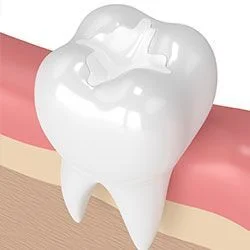
Traditional dental restoratives, or fillings, may include gold, porcelain, and composite. The strength and durability of traditional dental materials continue to make them useful for situations where restored teeth must withstand extreme forces that result from chewing, such as in the back of the mouth.
Newer dental fillings include ceramic and plastic compounds that mimic the appearance of natural teeth. These compounds, often called composite resins, are usually used on the front teeth where a natural appearance is important, as well as on the back teeth depending on the location and extent of the tooth decay.
What’s right for your child?
Several factors influence the performance, durability, longevity and expense of dental restorations, including:
- The components used in the filling material
- The amount of remaining tooth structure
- Where and how the filling is placed
- The chewing load the tooth will have to bear
- The length and number of visits needed to prepare and adjust the restored tooth
Before your child’s treatment begins, Dr. Von Gruben will discuss all options and help you choose the best filling for your son or daughter’s particular case. It may be helpful to understand the two basic types of dental fillings: direct and indirect.
- Direct fillings are placed immediately into a prepared cavity in a single visit. They include glass ionomers, resin ionomers, and composite (resin) fillings. A dentist prepares the tooth, places the filling, and adjusts it in just one appointment.
- Indirect fillings generally require two or more visits. They include inlays, onlays, veneers, crowns, and bridges fabricated with gold, base metal alloys, ceramics, or composites. During the first visit, a dentist prepares the tooth and makes an impression of the area to be restored. Then the dentist places a temporary covering over the prepared tooth. The impression is sent to a dental laboratory that creates the dental restoration. At the next appointment, the dentist cements the restoration into the prepared cavity and adjusts it as needed.

Bonding
Bonding is a conservative way to repair slightly chipped, discolored, or crooked teeth. During dental bonding, a white filling is placed onto your tooth to improve its appearance. The filling “bonds” with your teeth, and because it comes in a variety of tooth-colored shades, it closely matches the appearance of your natural teeth.
Tooth bonding can also be used for teeth fillings instead of amalgam fillings. Many patients prefer bonded fillings because the white color is much less noticeable than the silver amalgam fillings. Bonding fillings can be used on front and back teeth depending on the location and extent of tooth decay.
Bonding is less expensive than other cosmetic treatments and usually can be completed in one visit to our office. However, bonding can stain and is easier to break than other cosmetic treatments such as porcelain veneers. If it does break or chip, tell your doctor. The bonding generally can be easily patched or repaired in one visit.
